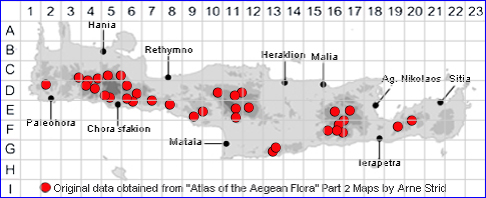
MYOSOTIS INCRASSATA
Family:- BORAGINACEAE
Common Names:- None
Synonyms:- Myosotis pusilla subsp. incrassata.
Meaning:- Myosotis (Gr) Mouse-ear, A name used by the Greek physician and
botanist Dioscorides.
Incrassata (L) Very thick, made stout.
General description:- Annual, covered with straight, bristle-shaped hairs.
Stem:-
a) 5-20 cm.
b) ascending to erect.
c) often much-branched at the base.
d) with spreading appressed hairs at the base.
Leaves:-
a) with hairs forwards pointing.
1) Basal:
a) 4 x 1 cm.
2) Cauline:
a) smaller.
b) ovate-lance-shaped.
Flowers:-
1) Inflorescence:
a) with numerous flowers; the stalks (pedicels) club-shaped (clavate) in fruit,
thickened towards apex.
2) Calyces:
a) in 2 regular rows when in fruit, usually pointing upwards, rarely appressed,
often deciduous.
3) Corolla:
a) Limb, up to 3 mm diam.
b) saucer-shaped.
c) blue, rarely white.
d) tube shorter than the calyx.
Fruit:-
1) Nutlets:
a) up to 1·2 mm.
b) brown.
c) without a rim.
d) attachment-area with 2 marginal grooves.
Key features:-
1) Calyces in fruit rarely appressed, less than 3 mm and not crowded.
Habitat:- Dry, sandy habitats, rocky flats, fallow fields, open grassland 0-1200 m.
Distribution:- Most of Greece, but rare in the west and far NE. C & E
Mediterranean area from Italy and Sicily to S Anatolia. Limited distribution on Crete
confined mainly to the four massifs.
Flowering time:- Mar to mid-June.
Photos by:- Fotis Samaritakis
SPECIES DESCRIPTION
